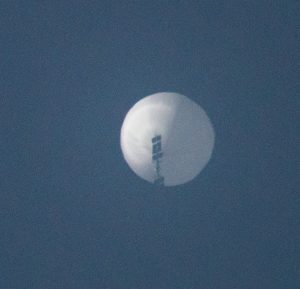
Ben Domenech writes a clear piece of reflection in The Transom.
Why was a surveillance balloon from China hovering over Montana’s Malmstrom Air Force Base, which, according to the Pentagon, maintains some 150 intercontinental ballistic missile silos? And why was the Biden Administration hiding this fact from the country?
Xi is smiling down on you
Don’t Look Directly At The Balloon
Xi is smiling down on you
We weren’t supposed to notice the floating intruder. According to Bloomberg, the federal government was already aware of the balloon, and had been for several days, but they wished to keep the matter on the “down-low” so as not to disrupt a coming meeting between Secretary of State Antony Blinken and high Chinese officials.Too bad for the bigwigs. They miscalculated, perhaps because they dwell in cities, where people tend to stare into their phones rather than idly admiring the heavens, spotting anomalous aircraft now and then.
Once eagle-eyed Montanans had seen the balloon and Americans came to discover that the country’s military elite was allowing a giant bag of gas hooked to a payload of surveillance gear to bob along unmolested above our nukes and, as it just happened, my house, a minor national panic followed.
My phone lit up with texts from distant friends and my Twitter feed with comments and questions that ranged from serious to tensely humorous.
Were my fellow Montanans planning to take up arms against this violator of our airspace? Weren’t we famously cranky and given to self-defense? And what about Montana’s Malmstrom Air Force Base, which, according to the Pentagon, maintains some 150 intercontinental ballistic missile silos?
As the balloon peered down upon my state, its intentions uncertain and its presence a bit humiliating, the stereotypes about Montana flowed. Much mention was made of the hit TV show, Yellowstone, which lately has spun off a couple of other shows set deep in the state’s romantic, roaring past. In all of them, Montanans are portrayed as quick to anger, intensely self-sufficient, instinctively hostile to rich and fancy outsiders. In other words, not the sort of people to sink back into their Instagram accounts when confronted with giant airborne trespassers.
I’ll admit it, the comments—and the balloon itself, hovering so smugly out of range of the dusty hunting rifle I own—put me in a touchy mood. For though I was proud we’d spotted the damn thing and raised an alarm that sounded across the continent (neighboring Canada hadn’t made a peep during the craft’s stealthy transit through its time zones), I’d just about had it with all the public attention recently paid to Montana.
Just a few weeks back, I sat down with my morning coffee, opened up the paper, and learned that I now live in a quasi-fascist state. It said so in the paper.
The paper wasn’t a local publication but one from a couple of thousand miles away, the New York Times, whose glossy Sunday magazine included a lengthy, illustrated feature with the five-alarm headline How Montana Took a Hard Right Turn Toward Christian Nationalism. To illustrate the state’s alleged swerve toward neo-fascist theocratic rule—a dire development I’d somehow missed—the story included a scary gothic photo, heavily filtered to bring out its dark tones, of a ghostly white cross on a bare hillside reflected in a passing rearview mirror. It also included, of course, a Yellowstone reference and Kevin Costner’s name—right up top, where the search engines would see them.
Since moving to small-town Montana from New York City over 30 years ago, I’d lived through at least a couple of cycles of ominous national coverage of my state. Without going into the details, let me assure you that this article was bunk, as exaggerated as the photo.
But fiction is fact where Montana is concerned, particularly on the country’s coasts, where tales are told about the country’s interior that the country’s interior lacks the clout to counter, much as our guns lack the range to bring down aircraft. Despite our legendary swagger, Montanans are largely helpless against the country’s more powerful forces. The missiles on our prairies aren’t missiles we asked for, just missiles that formidable others wished to plant here. They make us a target, but we don’t control them.
Do I sound defensive? Perhaps I am.
I live in a state with zero big-league sports teams, not a single Fortune 500 corporation, and no national media influence to speak of—unless you count made-up shows about fake ranchers slugging it out in scripted brawls. I’m one of about a million residents, all of whom, no matter their circumstances, are up against the myth-making machines of cities and states of imperial wealth and numbers. And imperial attitudes, dare I say, which emerge in their basic, perennial story about us: those folks from the steppes and mountains are growing restless, including the ones who’ve just moved there to go skiing, who appear to be worse than the ones already living there, who we’ve always found unsettling enough.
When the spy balloon floated across America, the rest of the country got a taste, perhaps, of Montana’s stoic colonial impotence. For days, we could point, but we weren’t allowed to shoot —great-power diplomacy prevented it. Americans may think we’re tough, as Montanans may think they’re tough, but it seems that we’re tough in the way that actors in westerns are: only with the permission of the director, only symbolically. Down went the balloon on Saturday to much applause, but the spectacle was pure cinema by then, like a fistfight on Yellowstone that draws fake blood.
More on the Chinese balloon from Rebeccah Heinrichs in The Spectator.

